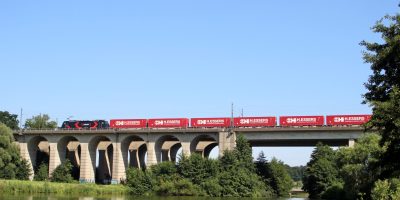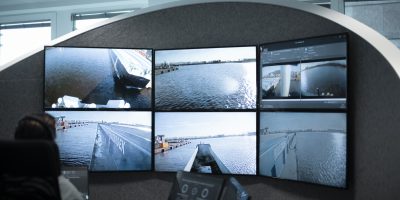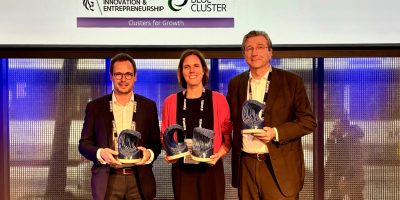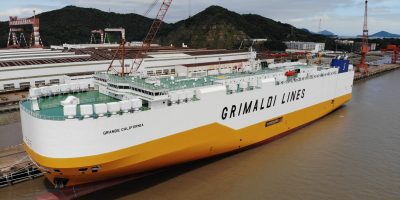
Antoon Van Coillie launched his first innovative pallet shuttle barge ‘Zulu’ with Blue Line Logistics in 2014. Now almost a decade later, preparations are under way to build the first autonomous, unmanned barge ‘X-Barge’. You can also read this contribution in the anniversary edition of the magazine ’10 years of Flows’.
Six ‘Zulu’s’
Two years after launching the first ‘Zulu’s’, Van Coillie met French group Sogestran in Paris. “They had a ship with lifts to load and unload pallets, but it was complicated. In 2016, they joined Blue Line Logistics on board. Then the ‘Zulu 3’ and ‘Zulu 4’ were built. Sogestran acquired 100% of Blue Line Logistics in 2019. They added two more, slightly larger, vessels. ‘Zulu’ 3, 5 and 6 operate in France. ‘Zulu 6’, meanwhile, runs on hydrogen. With the ‘Zulu 3’, they are continuously doing tests for urban distribution.”
The three other ‘Zulu’s’ are used for Viapaletto and by waste intercommunal IOK, among others. “We had discovered that we could put roll containers on and off the vessels and that became an ongoing business with IOK on the small canals. We chartered the ‘Zulu 4’ back with Zulu Associates for the European Autoship project for autonomous sailing. The Hydraulic Laboratory is also using it for tests to pass through locks more efficiently. We may also charter it to go through locks without docking. That should be possible if the ship has sufficient ‘dynamic positioning’. With just a propeller and a propeller, it won’t work. Then you have to anchor the ship”.
Autonomous navigation
The idea of autonomous sailing also came by chance. “In 2016, I already had two years of experience with the ‘Zulu’. That was cool because I had already done some sailing in the navy, on Tall Ships, and so on. Every day I went to the yard in Hemiksem to see how they built the ‘Zulu’s’. I bought books on the technique of welding. At one point, I had hired a motor yacht to sail on the canal, but sailing ten to 12 kilometres on a straight stretch is boring. So I came up with the idea of finding a way where we don’t need anyone on board. Those people, with their competence, can be deployed in the right places and at times when supervision is needed. That’s how the quest for autonomous sailing started from 2016.”
He first talked to Rolls Royce’s ship division in Norway and then to Norway’s Kongsberg, which had taken over the ship division. That’s how he ended up at Autoship. “There we ended up using the ‘Zulu 4’ as a test machine for autonomous sailing, especially in terms of the navigation system. During the demo, someone was still on board because you could still sail with the existing regulations. In 2019, that was an evolution. I then asked Sogestran to co-invest, but they did not believe in it. I negotiated with the boss of Sogestran, Pascal Girardet, also a fantastic CEO. He then took over Blue Line Logistics completely. I continued with Zulu Associates,” Van Coillie says.
‘X-Barge’
With Zulu Associates, Antoon Van Coillie was able to fully focus on autonomous shipping from then on. “We are now in a phase to take the next step. This means, among other things, that we are preparing a capital increase to build the first X-Barge. The plans are in the final stages and we are also already negotiating with energy providers. We will initially work with batteries. By the end of 2023, we hope to appoint the yard that will build the first two ships. By the end of 2024, they will then hopefully be in the water.”
A process will follow in which there will still be crew on board, but what they will phase out afterwards. Legislation, regulations and police regulations also need to be changed. “Flanders is already working on that and we have good discussions with the administration. If we move in that direction, we in Flanders will have an advantage over other countries. That can be monetised for the benefit of our maritime industry. It is a fascinating evolution, not only with autonomous sailing, but also in alternative propulsion. On the one hand, you have the hydrogen story with ‘fuel cells’. Future Proof Shipping is already sailing with that and it works. ABC and CMB.TECH have also made a lot of progress there in the last two to three years. In terms of batteries, there are also a number of players in the market such as ZES and Zenobe. Moreover, the capacity of batteries is increasing substantially. That does mean that in the future we will no longer be bunkering for a fortnight. It will be a different way of working. Digitalisation is a strong weapon to realise those changes. Alternative propulsion – including via wind and foils for seagoing vessels – and autonomous sailing are the two big leaps for me.”
No more big ships
Another hobbyhorse of Antoon Van Coillie is the fact that no more big ships are needed. “The size of a ship is related to the distance it travels. For long distances, a big ship is good, but for smaller distances of two hundred to three hundred kilometres, you don’t need big ships. Especially if we really want to have a modal shift to inland shipping with pallets, bulk or containers.”
He sees a number of new companies like Seafar, Mahi, Dot Ocean and institutions like De Blauwe Cluster, the Universities of Leuven and Ghent and the Hydraulic Laboratory working on water-related innovations. “The evolution will be rapid. It also has to because of the climate crisis. 2030 is tomorrow. Yet a number of people remain in the old system. People are also being mis-educated. They should no longer learn how to live aboard a ship, but how to sail and what a ship is, even if they will work on screens afterwards. We need new profiles, much more towards electromechanics rather than diesel.”
“Also on a legal level, lawyers are already thinking about what it means to sail autonomously. How will a Brabo deal with such a ship as a service provider when capturing? What will happen in the port? These are all new tasks and jobs that are starting to take shape. Insurance-wise, it will also be a different sector. The ‘X-Barge’ will be monitored from a ‘remote control centre’ because that’s what is needed from an insurance point of view. That also needs to be built. The economic leverage is much greater than people think. That is why the government is benevolent and we have to go for it. We are one of the driving parties. We won’t be able to do otherwise, because in 10 years there will be no more boaters. The modal shift will also be much easier with autonomous shipping,” concludes Antoon Van Coillie.




